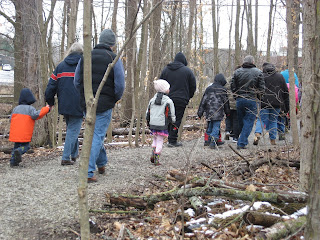Maple Fest 2016
Our county parks department puts on a Maple Fest in the even numbered years. And so, out we went. This is a modern tapping system - plastic spilees, plastic tubes, and a plastic collection bag.
Not a typical collection bucket, but it let us see the sap dripping out of the tree. Sap can run for as little as 6 days or as much as 6 weeks. It all depends on the temperatures.
Trees are typically tapped in late winter or early spring, but it isn't the date they go by, but the temperatures. To make the sap run, temps must be below freezing at night and above freezing during the day.
Maple trees (ash, dogwood and one other) grow branches directly opposite each other. That plus the 5-pronged leaf make them easy to identify.
Native americans were the first to collect maple sap and cook it down to sugar which was easily stored. They heated the sap by heating rocks by the fire and setting the hot rocks into a container (hollowed log, tightly woven basket, or pottery dish) containing the sap.
The fire, rocks, and sap had to be tended by the women and children all day long. Ash was strained out using a woven grass straining tool.
Maple sugar - the preferred method of keeping maple sweetening around for use and trade.
Pioneers came along with their cast iron cooking pots and refined the process a bit. Starting with the raw sap in the largest pot and cooking it down, pouring it into smaller and smaller pots ...
until they also ended up with a firm lump of maple sugar. It's the cone-shaped thing in the middle of the photo.
It' takes 40 gallons of sap to produce 1 gallon of syrup. And you wondered why real maple syrup cost so much more than the fake stuff. Now you know.
Evolution of the spile, used to tap the trees and drain the sap.
Our group. That's my husband in the black vest and daughter in the pink hat.
Yellow-bellied sapsuckers are a breed of woodpecker bird known for their own maple tree sap collection methods.
One bird will tap a row of holes all the way around a tree, leave for a couple hours, and come back to a lovely meal of maple sap. An added bonus is if the ants have arrived before their return.
And the modern method of cooking down the sap - a 4-bin wood-burning cooker. Maple sap is 97.5% water and just 2.5% sugar.
Early in the season syrup is light-colored (golden) and with a lighter flavor. Dark syrup is from later sap. Ohio ranks 4th or 5th most years in maple syrup production. Vermont is 1st of the states. Canada is 1st in the world. That said, maple syrup is a Canada and eastern, north of Kentucky US thing.
A warm pancake with a bit of real maple syrup. Yum!
And of course, when we got home we cooked up some pancakes and sausages to have with real maple syrup.
Cheers - Ann


















Comments
Post a Comment